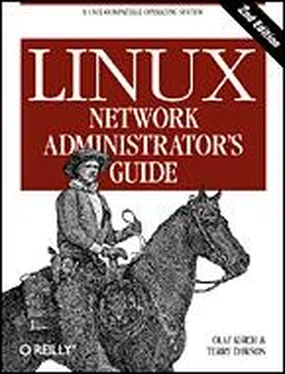Hostname or IP address
This field conforms to wildmat(3) pattern-matching rules. It is a pattern that describes the connecting host's name or IP address.
Permissions
This field determines what permissions the matching host should be granted. There are two permissons you may configure: R gives read permissions, and P gives posting permissions.
Username
This field is optional and allows you to specify a username that an NNTP client must log into the server before being allowed to post news articles. This field may be left blank. No user authentication is required to read articles.
Password
This field is optional and is the password accompanying the username field. Leaving this field blank means that no password is required to post articles.
Newsgroups
This field is a pattern specifying which newsgroups the client is allowed to access. The pattern follows the same rules as those used in the newsfeeds file. The default for this field is no newsgroups, so you would normally have a pattern configured here.
In the virtual brewery example, we will allow any NNTP client in the Virtual Brewery domain to both read and post to all newsgroups. We will allow any NNTP client read-only access to all newsgroups except our private internal newsgroup. Our nnrp.access file will look like this:
# Virtual Brewery - nnrp.access
# We will allow public reading of all newsgroups except our private one.
*:R:::*,!rec.crafts.brewing.private
# Any host with the Virtual Brewery domain may Read and Post to all
# newsgroups
*.vbrew.com:RP::*
When news articles are received by a news server, they are stored to disk. News articles need to be available to users for some period of time to be useful, so a large operating news server can consume lots of disk space. To ensure that the disk space is used effectively, you can opt to delete news articles automatically after a period of time. This is called article expiration. Naturally, INN provides a means of automatically expiring news articles.
The INN server uses a program called expire to delete expired news articles. The expire program in turn uses a file called /etc/news/expire.ctl to configure the rules that govern article expiration.
The syntax of /etc/news/expire.ctl is fairly simple. As with most configuration files, empty lines or lines beginning with the # character are ignored. The general idea is that you specify one rule per line. Each rule defines how article expiration will be performed on newsgroups matching a supplied pattern. The rule syntax looks like this:
pattern : modflag : keep : default : purge
The following list describes the fields:
pattern
This field is a comma-delimited list of patterns matching names of newsgroups. The wildmat (3) routine is used to match these patterns. The last rule matching a newsgroup name is the one that is applied, so if you want to specify wildcard (*) rules, they should be listed first in this file.
modflag
This flag describes how this rule applies to moderated newsgroups. It can be coded with an M to mean that this rule applies only to moderated newsgroups, a U to mean that this rule applies only to unmoderated newsgroups, or an A to mean that this rule ignores the moderated status and applies to all groups.
keep
This field allows you to specify the minimum time an article with an "Expires" header will be kept before it is expired. The units are days, and are a floating point, so you may specify values like 7.5 for seven-and-a-half days. You may also specify never if you wish articles to stay in a newsgroup forever.
default
This field is the most important. This field allows you to specify the time an article without an Expires header will be kept. Most articles won't have an Expires header. This field is coded in the same way as the keep field, with never meaning that articles without Expires headers will never be expired.
purge
This field allows you to specify the maximum time an article with an Expires header will be kept before it is expired. The coding of this field is the same as for the keep field.
Our requirements are simple. We will keep all articles in all newsgroups for 14 days by default, and between 7 and 21 days for articles that have an Expires header. The rec.crafts.brewing.private newsgroup is our internal newsgroup, so we'll make sure we don't expire any articles from it:
# expire.ctl file for the Virtual Brewery
# Expire all articles in 14 days by default, 7-21 days for those with
# Expires: headers
*:A:7:14:21
# This is a special internal newsgroup, which we will never expire.
rec.crafts.brewing.private:A:never:never:never
We will mention one special type of entry you may have in your /etc/news/expires.ctl file. You may have exactly one line that looks like this:
/remember/: days
This entry allows you to specify the minimum number of days that an article will be remembered in the history file, irrespective of whether the article itself has been expired or not. This might be useful if one of the sites that is feeding you articles is infrequent and has a habit of sending you old articles every now and again. Setting the /remember/ field helps to prevent the upstream server from sending you the article again, even if it has already been expired from your server. If your server remembers it has already received the article, it will reject attempts to resend it. It is important to remember that this setting has no effect at all on article expiration; it affects only the time that details of an article are kept in the history database.
Handling Control Messages
Just as with C News, INN can automatically process control messages. INN provides a powerful configuration mechanism to control what action will occur for each of a variety of control messages, and an access control mechanism to control who can initiate actions against which newsgroups.
The control.ctl file is fairly simple in structure. The syntax rules for this file are much the same as for the other INN configuration files. Lines beginning with # are ignored, lines may be continued using /, and fields are delimited by:.
When a control message is received, it is tested against each rule in turn. The last rule in the file that matches the message is the rule that will be used, so you should put any generic rules at the start of the file and more specific rules at the end of the file. The general syntax of the file is:
message : from : newsgroups : action
The meanings of each of the fields are:
message
This is the name of the control message. Typical control messages are described later.
from
This is a shell-style pattern matching the email address of the person sending the message. The email address is converted to lowercase before comparison.
newsgroups
If the control message is newgroup or rmgroup, this field is a shell-style pattern matching the newsgroup created or removed.
action
This field specifies what action to take for any message matching the rule. There are quite a number of actions we can take; they are described in the next list.
The message field of each line can have one of the following values:
Читать дальше



![Andrew Radford - Linguistics An Introduction [Second Edition]](/books/397851/andrew-radford-linguistics-an-introduction-second-thumb.webp)








